I’ve been in Prato, Italy for three days now, and am happily adjusting to the abundant sun and the slower pace of life. I spent last week in London and had a blast zipping about the city, riding the Tube everywhere and exploring the city’s Chinese community (more on this later). But I did this all while bundled up in layers and frequently through the rain; even a romantic mist can wear you down after a while.
Here in Prato, a Tuscan town about a half hour’s train ride from Florence, palm trees stand beside white stucco houses topped with orange roofs. Church bells chime throughout the day and no one, it seems, is in a rush. From one to three o’clock each afternoon, businesses shut their doors and everyone goes home for a leisurely lunch.
Well, not quite everyone; the Chinese in Prato keep working.
I’d read a lot about the Chinese in Prato, who’ve made headlines in recent years for the success they’ve had in the pronto moda – fast fashion – business. But still I’ve been astounded by just how many Chinese people are here.
Walking down Via Pistoiese, the long, narrow street that forms the central artery of Prato’s Chinatown, I discovered that most of the people on the streets and in the shops are Chinese. Wenzhounese is the language most commonly heard, while Mandarin is second and Italian a distant third. Of Prato’s 200,000 residents, about 40,000 are Chinese; one-fifth of the city’s population is Chinese.
Stretching northwest from Porta Pistoiese, a 14th-century stone gate that demarcates the edge of the old city, Via Pistoiese doesn’t at first look too different from other streets in Prato. But nearly all the store signs feature Chinese, and the shops lining the street offer just about every product and service that Chinese immigrants may need: Wenzhou-style food, fashions plucked from Shanghai (some of the Chinese here favor the all-black look you might recognize from mafia or triad movies), hair salons, graphic design services, traditional Chinese medicine, mobile phones and electronics, Chinese groceries, wedding photography studios and Chinese classes for children.
The Chinese neighborhood – some locals describe it as a ghetto – is growing, and some Chinese have also started to settle in other areas in Prato. Especially troubling to many Italians is the fact that Chinese businesses have set up shop in the center of the old town as Italian-owned businesses have shut down or moved away. Some of these endeavors, like the cafes, cater to Italian as well as Chinese customers. But others, such as the clothing stores, exclusively target the local Chinese.
Say the name “Prato” in Italy, one Pratese told me, and it’s now synonymous with Chinatown.
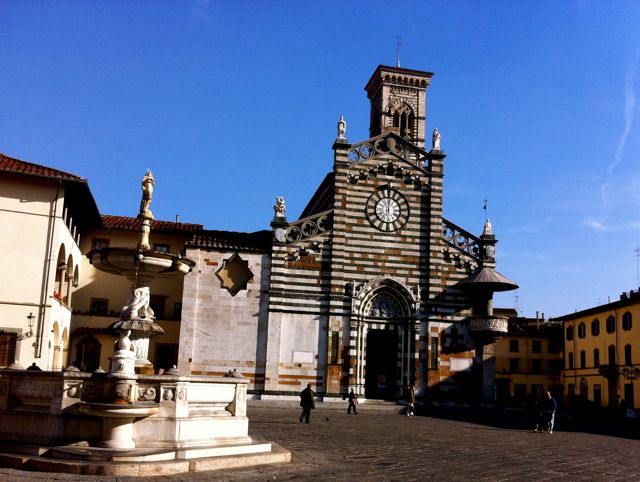
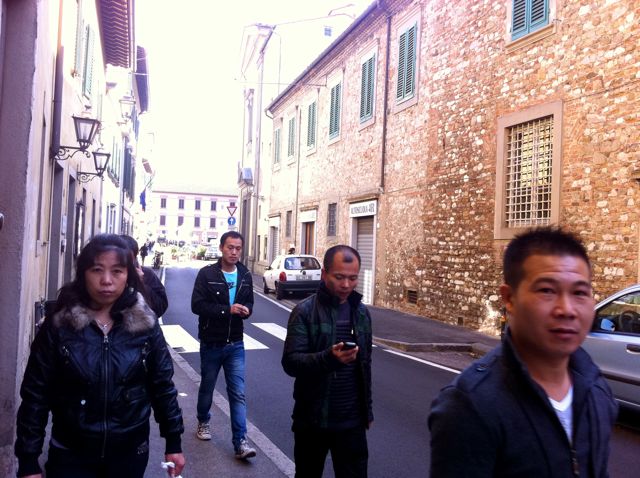
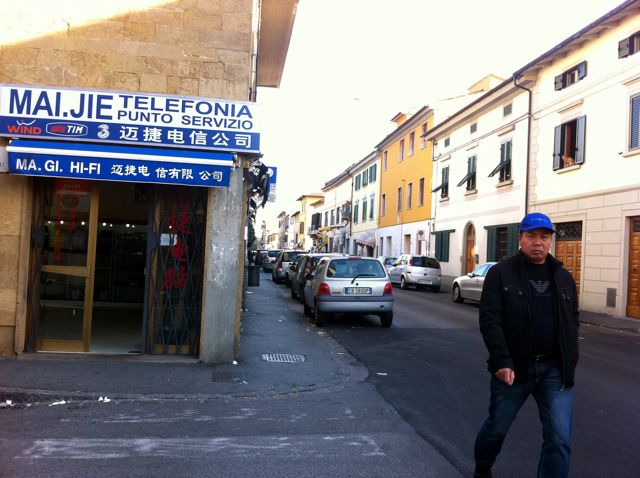
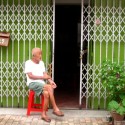


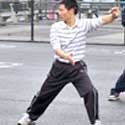

This is fascinating. I’ve noticed a lot of Chinese owned clothing stores with the latest trends popping up around Soho near Chinatown . Wonder if they have Prato connections?
I’m really astonished from the superficial comments abt my town. You had visited the centre of the town and one street and suppose to understand our original way of life, it’s fantastic! it’s like I come to SF and visit China town only and from that I pretend to comments the life there… Prato’s centre is only one small part of the twon and China Town (as you call Pistoiese street) is a small part closed to the centre. You write abt chinese people and seems they are very active vs too much relaxed Italians… at first more than 3/4 of Chinese are unlegal and it means they are 10.000 legal on 200.000 citizens, second they activities are mostly unlegal too, without any safe protection, without any “human” right, without payng taxes, without giving to the workers any right payment.
I invite you to come back here and give a right and deep look
bye.
Enrico, I wrote this post just after I arrived in Prato, but I actually spent three weeks in the town. You raise many interesting points, and I certainly talked to Pratesi who had similar concerns. I’ll be adding new blog posts soon — stay tuned!
I’m really abstonished about the enormous quantity of bullshit you arrive to publish on your blog.
The chinese community has been destroying prato since they start arriving.
They stink and they have bad condition of life, they are filling our hospitals with their sicknesses and they don’t even pay taxes, but they have full access to OUR structures. I wonder how you may feel if a malodorous yellow crowd would invade your country and destroy all work possibilities in there, and after that start committing robberies, blackmailing and killing innocent people for money.
.I really would like to be free to express my racism, so all this stinking riffraff would think twice to contaminate our town.
This might really be something interesting for you to write, instyead of wasting your time writing bullshits without sense.
Please come back to prato and I will be very glad to accomodate you in a factory, surrounded by people that live in filth, that I would prefer to call as animals.
The main problem we have is that, neither chinese peolpe accept them back home. I wonder to know why.
@JackMuch I agree with everything that ItalianPanda has said below. Your comments are ridiculous pieces of batshit. A lot of your complaints are such retrograde pieces of analyses: “they are filling our hospitals with their sicknesses and they don’t even pay taxes, but they have full access to OUR structures.” Immigrants, especially ILLEGAL immigrants, don’t want attention to be drawn to them, and subsequently use LESS of public services than the average citizen, if ANY AT ALL. They would actually not commit any ‘robberies’ or crimes as you have described. In fact, in the US, where many of these large scale immigration studies have been conducted, WHITE MEN are MORE LIKELY to commit felonies than comparable ILLEGAL IMMIGRANTS such as HISPANIC MALES. Therefore, this complaint is marginal, for while immigration might increase the AMOUNT of taxpayer expense, there are more taxpayers to cover it, and while it may increase the NUMBER of crimes, the CRIME RATE will STAY THE SAME or even go down because of the influx of immigrants.
And what’s happening to Italy right now? It’s in an economic morass! It was in danger of pulling a Greece at one point, and it’s one of the lowest points on the EU! As much as I love Italy, this is mostly to due to the aging population and the xenophobic behavior of the Italian government that restricts immigration. Why the UK, US, and Australia, have been able to stay barely afloat in this recession is a constant stream of immigration which replenishes its work force. Japan, a traditionally xenophobic nation, has been in a morass for decades and like Italy, it also has a negative birth rate! Like it or not, buddy, the world is becoming more global, and those who have racist tendencies like you have no place in this upcoming world.
Also, one thing to say in favor of illegal immigration: the price level. Say without illegal labor that a cabbage costs $4. With illegal labor: $2. Whether you like it or not, illegal labor is a huge function in the global economy, and while you might not think much of a $2 hike, think about the rest of the economy’s price level and productivity. I am not endorsing illegal labor, but just looking at its current place.
I do not deny your views that Chinese people are “stinky” and “yellow”–that’s your thoughts, though regrettable and unforgivably racist, I hold no claim to control them, or anyone else–but the moment you start to deny their rights and opportunities and start spewing all of this nonsense which has no grounding whatsoever, you are in danger and you will lose what little respect you had accorded to you. And also, no one knows you’re a dog on the internet.
ML
@Jackmuch
Do you have any chinese friend? So stop talking about something you dont know.
“The chinese community has been destroying prato since they start arriving.”
Those chinese have created this huge ProntoModa district giving works to a lot of peoples, including italians!
“Church bells chime throughout the day and no one, it seems, is in a rush.” i think you have been spending most of yr time here between S.domenico – square and via pistoiese, i do agree with mr Mancantelli this is the most superficial point of wiew i have never heard about my city.
you should go deeper into the reasons why such a big chinese community has decided to come here and really checkwhat is happening here, why many chineses are exploited form chineses itself and also from some textile enterprises owned by people of prato. think that 3 weeks of permanence should have been enough to produce a wider thoguht about it.
Dears
we have sons who are going to school with chinese fellow and we have knloledge of their fparents, besides we are leaving in prato and I do not accept moralist lessons from who is coming here to stay few weks without have any idea abt prato history and culture.
The truue story is the chinese comunity is for the major part unlegally, their business is unlegal and hide to the oncpming taxation, the major workers are working as the black people was in usa before 1860, eating on the sawlng machines and sleeping under the cuting tables, without a real bed and bathroom is a dream, they do not have wc and the factories are old and terrible small and humid and cold in winter and hot in summer
this is the true and nobody can denay it.